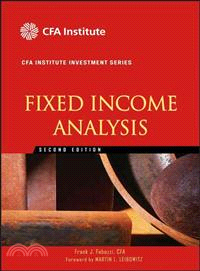| FindBook |
有 1 項符合
FIXED INCOME ANALYSIS(SECOND EDITION)的圖書 |
 |
FIXED INCOME ANALYSIS(SECOND EDITION) 作者:Fabozzi 出版社:JOHN WILEY & SONS,LTD 出版日期:2006-12-27 規格:26.0*19.1*4.4cm / 精裝 / 768頁 |
| 圖書館借閱 |
| 國家圖書館 | 全國圖書書目資訊網 | 國立公共資訊圖書館 | 電子書服務平台 | MetaCat 跨館整合查詢 |
| 臺北市立圖書館 | 新北市立圖書館 | 基隆市公共圖書館 | 桃園市立圖書館 | 新竹縣公共圖書館 |
| 苗栗縣立圖書館 | 臺中市立圖書館 | 彰化縣公共圖書館 | 南投縣文化局 | 雲林縣公共圖書館 |
| 嘉義縣圖書館 | 臺南市立圖書館 | 高雄市立圖書館 | 屏東縣公共圖書館 | 宜蘭縣公共圖書館 |
| 花蓮縣文化局 | 臺東縣文化處 |
|
|
- 圖書簡介
In the Second Edition of Fixed Income Analysis, financial expert Frank Fabozzi and a team of knowledgeable contributors provide complete coverage of the most important issues in fixed income analysis.
Now, in Fixed Income Analysis Workbook, Second Edition, Fabozzi offers you a wealth of practical information and exercises that will solidify your understanding of the tools and techniques associated with this discipline. This comprehensive study guide--which parallels the main book chapter by chapter--contains challenging problems and a complete set of solutions as well as concise learning outcome statements and summary overviews.
If you want to make the most of your time in the fixed income marketplace, the lessons within this workbook can show you how. Topics reviewed include:
The risks associated with investing in fixed income securities
The fundamentals of valuation and interest rate risk
The features of structured products--such as mortgage-backed securities and asset-backed securities
The principles of credit analysis
The valuation of fixed income securities with embedded options
WileyPLUS
for Fixed Income Analysis, 2nd Edition. Learn more at WileyPLUS.com - 作者簡介
FRANK J. FABOZZI, PhD, CFA, CFP, is an Adjunct Professor of Finance and Becton Fellow at Yale University's School of Management. He is also Editor of the Journal of Portfolio Management, and a consultant.
- 目次
Foreword.
Acknowledgments.
Introduction.
Note on Rounding Differences.
CHAPTER 1: Features of Debt Securities.
I. Introduction.
II. Indenture and Covenants.
III. Maturity.
IV. Par Value.
V. Coupon Rate.
VI. Provisions for Paying Off Bonds.
VII. Conversion Privilege.
VIII. Put Provision.
IX. Currency Denomination.
X. Embedded Options.
XI. Borrowing Funds to Purchase Bonds.
CHAPTER 2: Risks Associated with Investing in Bonds.
I. Introduction.
II. Interest Rate Risk.
III. Yield Curve Risk.
IV. Call and Prepayment Risk.
V. Reinvestment Risk.
VI. Credit Risk.
VII. Liquidity Risk.
VIII. Exchange Rate or Currency Risk.
IX. Inflation or Purchasing Power Risk.
X. Volatility Risk.
XI. Event Risk.
XII. Sovereign Risk.
CHAPTER 3: Overview of Bond Sectors and Instruments.
I. Introduction.
II. Sectors of the Bond Market.
III. Sovereign Bonds.
IV. Semi-Government/Agency Bonds.
V. State and Local Governments.
VI. Corporate Debt Securities.
VII. Asset-Backed Securities.
VIII. Collateralized Debt Obligations.
IX. Primary Market and Secondary Market for Bonds.
CHAPTER 4: Understanding Yield Spreads.
I. Introduction.
II. Interest Rate Determination.
III. U.S. Treasury Rates.
IV. Yields on Non-Treasury Securities.
V. Non-U.S. Interest Rates.
VI. Swap Spreads.
CHAPTER 5: Introduction to the Valuation of Debt Securities.
I. Introduction.
II. General Principles of Valuation.
III. Traditional Approach to Valuation.
IV. The Arbitrage-Free Valuation Approach.
V. Valuation Models.
CHAPTER 6: Yield Measures, Spot Rates, and Forward Rates.
I. Introduction.
II. Sources of Return.
III. Traditional Yield Measures.
IV. Theoretical Spot Rates.
V. Forward Rates.
CHAPTER 7: Introduction to the Measurement of Interest Rate Risk.
I. Introduction.
II. The Full Valuation Approach.
III. Price Volatility Characteristics of Bonds.
IV. Duration.
V. Convexity Adjustment.
VI. Price Value of a Basis Point.
VII. The Importance of Yield Volatility.
CHAPTER 8: Term Structure and Volatility of Interest Rates.
I. Introduction.
II. Historical Look at the Treasury Yield Curve.
III. Treasury Returns Resulting from Yield Curve Movements.
IV. Constructing the Theoretical Spot Rate Curve for Treasuries.
V. The Swap Curve (LIBOR Curve).
VI. Expectations Theories of the Term Structure of Interest Rates.
VII. Measuring Yield Curve Risk.
VIII. Yield Volatility and Measurement.
CHAPTER 9: Valuing Bonds with Embedded Options.
I. Introduction.
II. Elements of a Bond Valuation Model.
III. Overview of the Bond Valuation Process.
IV. Review of How to Value an Option-Free Bond.
V. Valuing a Bond with an Embedded Option Using the Binomial Model.
VI. Valuing and Analyzing a Callable Bond.
VII. Valuing a Putable Bond.
VIII. Valuing a Step-Up Callable Note.
IX. Valuing a Capped Floater.
X. Analysis of Convertible Bonds.
CHAPTER 10: Mortgage-Backed Sector of the Bond Market.
I. Introduction.
II. Residential Mortgage Loans.
III. Mortgage Passthrough Securities.
IV. Collateralized Mortgage Obligations.
V. Stripped Mortgage-Backed Securities.
VI. Nonagency Residential Mortgage-Backed Securities.
VII. Commercial Mortgage-Backed Securities.
CHAPTER 11: Asset-Backed Sector of the BondMarket.
I. Introduction.
II. The Securitization Process and Features of ABS.
III. Home Equity Loans.
IV. Manufactured Housing-Backed Securities.
V. Residential MBS Outside the United States.
VI. Auto Loan-Backed Securities.
VII. Student Loan-Backed Securities.
VIII. SBA Loan-Backed Securities.
IX. Credit Card Receivable-Backed Securities.
X. Collateralized Debt Obligations.
CHAPTER 12: ValuingMortgage-Backed and Asset-Backed Securities.
I. Introduction.
II. Cash Flow Yield Analysis.
III. Zero-Volatility Spread.
IV. Monte Carlo Simulation Model and OAS.
V. Measuring Interest Rate Risk.
VI. Valuing Asset-Backed Securities.
VII. Valuing Any Security.
CHAPTER 13: Interest Rate Derivative Instruments.
I. Introduction.
II. Interest Rate Futures.
III. Interest Rate Options.
IV. Interest Rate Swaps.
V. Interest Rate Caps and Floors.
CHAPTER 14: Valuation of Interest Rate Derivative Instruments.
I. Introduction.
II. Interest Rate Futures Contracts.
III. Interest Rate Swaps.
IV. Options.
V. Caps and Floors.
CHAPTER 15: General Principles of Credit Analysis.
I. Introduction.
II. Credit Ratings.
III. Traditional Credit Analysis.
IV. Credit Scoring Models.
V. Credit Risk Models.
Appendix: Case Study.
CHAPTER 16: Introduction to Bond Portfolio Management.
I. Introduction.
II. Setting Investment Objectives for Fixed-Income Investors.
III. Developing and Implementing a Portfolio Strategy.
IV. Monitoring the Portfolio.
V. Adjusting the Portfolio.
CHAPTER 17: Measuring a Portfolio’s Risk Profile.
I. Introduction.
II. Review of Standard Deviation and Downside Risk Measures.
III. Tracking Error.
IV. Measuring a Portfolio’s Interest Rate Risk.
V. Measuring Yield Curve Risk.
VI. Spread Risk.
VII. Credit Risk.
VIII. Optionality Risk for Non-MBS.
IX. Risks of Investing in Mortgage-Backed Securities.
X. Multi-Factor Risk Models.
CHAPTER 18: Managing Funds against a Bond Market Index.
I. Introduction.
II. Degrees of Active Management.
III. Strategies.
IV. Scenario Analysis for Assessing Potential Performance.
V. Using Multi-Factor Risk Models in Portfolio Construction.
VI. Performance Evaluation.
VII. Leveraging Strategies.
CHAPTER 19: Portfolio Immunization and Cash Flow Matching.
I. Introduction.
II. Immunization Strategy for a Single Liability.
III. Contingent Immunization.
IV. Immunization for Multiple Liabilities.
V. Cash Flow Matching for Multiple Liabilities.
CHAPTER 20: Relative-ValueMethodologies for Global Credit Bond Portfolio Management (by Jack Malvey).
I. Introduction.
II. Credit Relative-Value Analysis.
III. Total Return Analysis.
IV. Primary Market Analysis.
V. Liquidity and Trading Analysis.
VI. Secondary Trade Rationales.
VII. Spread Analysis.
VIII. Structural Analysis.
IX. Credit Curve Analysis.
X. Credit Analysis.
XI. Asset Allocation/Sector Rotation.
CHAPTER 21: International Bond Portfolio Management (by Christopher B. Steward, J. Hank Lynch, and Frank J. Fabozzi).
I. Introduction.
II. Investment Objectives and Policy Statements.
III. Developing a Portfolio Strategy.
IV. Portfolio Construction.
Appendix.
CHAPTER 22: Controlling Interest Rate Risk with Derivatives (by Frank J. Fabozzi, Shrikant Ramamurthy, and Mark Pitts).
I. Introduction.
II. Controlling Interest Rate Risk with Futures.
III. Controlling Interest Rate Risk with Swaps.
IV. Hedging with Options.
V. Using Caps and Floors.
CHAPTER 23: HedgingMortgage Securities to Capture Relative Value (by Kenneth B. Dunn, Roberto M. Sella, and Frank J. Fabozzi).
I. Introduction.
II. The Problem.
III. Mortgage Security Risks.
IV. How Interest Rates Change Over Time.
V. Hedging Methodology.
VI. Hedging Cuspy-Coupon Mortgage Securities.
CHAPTER 24: Credit Derivatives in Bond Portfolio Management (by Mark J.P. Anson and Frank J. Fabozzi).
I. Introduction.
II. Market Participants.
III. Why Credit Risk Is Important.
IV. Total Return Swap.
V. Credit Default Products.
VI. Credit Spread Products.
VII. Synthetic Collateralized Debt Obligations.
VIII. Basket Default Swaps.
About the CFA Program.
About the Author.
About the Contributors.
Index.
|











